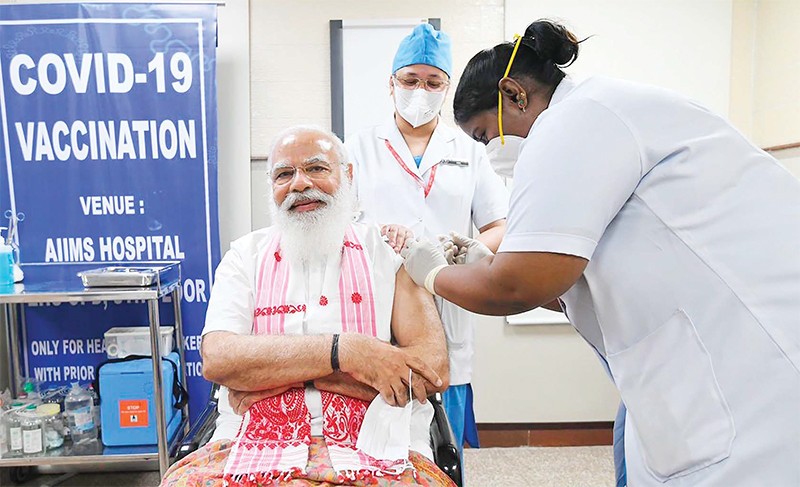01/03/2021
01/03/2021
NEW DELHI, March 1, (AP): India is expanding its coronavirus vaccination drive beyond health care and front-line workers, offering the shots to older people and those with medical conditions that put them at risk. Among the first to receive a vaccine on Monday was Prime Minister Narendra Modi. Those now eligible include anyone older than 60, as well as those over 45 who have ailments such as heart disease or diabetes that make them vulnerable to serious COVID-19 illness.

The shots will be given for free at government hospitals and will also be sold at over 10,000 private hospitals at a fixed price of 250 rupees, or $3.40, per shot. But the rollout of one of the world’s largest vaccination drives has been sluggish. Amid signs of hesitancy among the first groups offered the vaccine, Modi, who is 70, got a shot at New Delhi’s All India Institute of Medical Science. He received the vaccine produced by Indian vaccine maker Bharat Biotech - which has been met with particular skepticism. He appealed for all to get vaccinated, tweeting afterward, “together, let us make India COVID-19 free!”
Urgency
The drive, which began in January in the country of 1.4 billion people, has recently taken on even more urgency, since new infections have begun to increase again after months of consistent decline, and scientists have detected worrisome variants of the virus that they fear could hasten infections or render vaccines or treatments less useful. Scores of elderly people started lining up outside private hospitals on Monday morning. Sunita Kapoor was among them, waiting for a vaccine with her husband. She said that they had been staying at home and not meeting people for months to stay safe from the virus - and were looking forward to being able to socialize a bit more.
“We are excited,” said Kapoor, 63. Many said that they had struggled with the online system for registering and then waited in line for hours before receiving the vaccine - problems that other countries have also experienced. Dr Giridhar R. Babu, who studies epidemics at the Public Health Foundation of India, said that long waits for the elderly were a concern since they could pick up infections, including COVID- 19, at hospitals.
“The unintended effect might be that they get COVID when they go to get the vaccine,” he said. Even though India is home to the world’s largest vaccine makers and has one of the biggest immunization programs, things haven’t gone according to plan. Of the 10 million health care workers that the government had initially wanted to immunize, only 6.6 million have gotten the first shot of the two-dose vaccines and 2.4 million have gotten both. Of its estimated 20 million front-line workers, such as police or sanitation workers, only 5.1 million have been vaccinated so far.
Dr Gagangdeep Kang, an infectious diseases expert at Christian Medical College Vellore in southern India, said the hesitancy by health workers highlights the paucity of information available about the vaccines. If health workers are reticent, “you seriously think that the common public is going to walk up for the vaccine?” she said. Vaccinating more people quickly is a major priority for India, especially now that infections are rising again. Philippines launches vaccination campaign amid supply problems The country has recorded more than 11 million cases, second in the world behind the United States, and over 157,000 deaths. The government had set a target of immunizing 300 million people, nearly the total US population, by August.
Spike
The spike in infections in India is most pronounced in the western state of Maharashtra, where the number of active cases has nearly doubled to over 68,000 in the past two weeks. Lockdowns and other restrictions have been reimposed in some areas, and the state’s chief minister, Uddhav Thackeray, has warned that another wave of cases is “knocking on our door.” Similar surges have been reported from states in all corners of the massive country: Punjab, Jammu and Kashmir in the north, Gujarat in the west, West Bengal in the east, Madhya Pradesh and Chhattisgarh in central India, and Telangana in the south.
Top federal officials have asked authorities in those states to increase the speed of vaccinations in districts where cases are surging, and to track clusters of infections and monitor variants. “There is a sense of urgency because of the mutants and because cases are going up,” said Dr. K. Srinath Reddy, president of the Public Health Foundation of India. He said that the consistent dip in cases over months resulted in a “reduced threat perception,” leading to vaccine hesitancy. “The (vaccination) drive began when perception was that the worst was over, so people were more hesitant,” Reddy said.
Others have also pointed out that the reticence to get vaccinated was amplified, at least in part, by the government’s opaque decision making while greenlighting vaccines. But experts say that allowing private hospitals to administer the shots — which began with this new phase of the campaign — should improve access. India’s health care system is patchy, and in many small cities people depend on private hospitals for their medical needs. Still, problems remain. India had rolled out online software to keep track of the shots and recipients, but the system was prone to glitches and delays. The federal government will decide which hospitals get which vaccine and people will not have a choice between the AstraZeneca vaccine or the Bharat Biotech one, confirmed Dr. Amar Fettle, the nodal COVID-19 officer for southern Indian state Kerala. The latter got the go-ahead by Indian regulators in January before trials testing the shot’s effectiveness at preventing illness were completed. But opening up the campaign to private hospitals may allow the rich to “shop” around for places that are providing the AstraZeneca vaccine — an option that poorer people wouldn’t have, said Dr Anant Bhan, who studies medical ethics.


